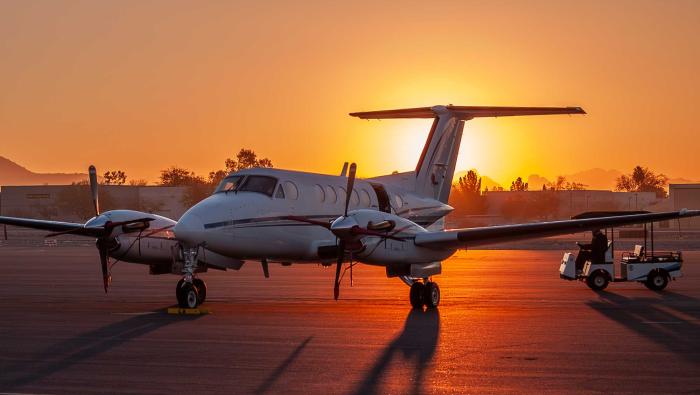
General aviation leaders and organizations are joining forces to support the 2026 Special Olympics Airlift, a national volunteer effort to transport athletes and coaches to the Special Olympics USA Games in Minnesota. Announced during EAA AirVenture 2025, the initiative is organized by Textron Aviation and endorsed by the Experimental Aircraft Association and GAMA.
Scheduled for June 19 and 27, 2026, the airlift will mobilize hundreds of Cessna, Beechcraft, and Hawker aircraft owners to fly participants to and from the event, with arrivals and departures set for St. Paul Downtown Airport (KSTP). Participating aircraft, known as “Doves,” are expected to land or take off every three minutes during a 10-hour period. The release called on operators of Citations, King Airs, and other aircraft to sign up to help next year.
Textron Aviation CEO Ron Draper called the effort “a powerful testament to the spirit of aviation and its ability to change lives,” while EAA chairman Jack Pelton described it as “a shining example of aviation’s heart.”
GAMA CEO James Viola added that the airlift “provides Special Olympics athletes and coaches with the transportation necessary to create lasting memories of the games and inspiring achievements by the competitors.”
More than 10,000 athletes and coaches have flown through past airlifts since 1987.
|
Loss of control in-flight (LOC-I) is the leading cause of fatal aircraft accidents worldwide. These accidents affect every aircraft type and every segment of aviation. Startle, surprise, and the psychophysiological effects of an aircraft upset can paralyze a pilot’s response unless they are properly trained.
Unlike past killers in aviation, the LOC-I threat persists on any flight, at any time, and pilots can have only a few seconds to initiate the proper flight control inputs to safely recover from an aircraft upset. If mismanaged, an in-flight upset can quickly escalate into a LOC-I event where the pilot is unable to recover from an unintended extreme deviation from the expected flight path due to either a lack of skill, altitude, or time, leading to a serious incident or fatal crash.
Put into context, according to Boeing’s annual statistical summary of aircraft accidents, LOC-I accidents top the list of fatal accidents in airliners. Fatalities from LOC-I accidents nearly outnumber the next three categories combined. Over the last decade, worldwide LOC-I accidents have killed 428 people, compared with 459 killed from bird strikes, system component failure (non-powerplant), and runway excursions combined.
In general aviation, 40% of all accidents are attributed to LOC-I, making it the leading killer. In fact, the next six accident categories combined do not top LOC-I as a leading cause of fatal accidents.
|
The Italian government this week confirmed an order for a pair of Gulfstream G550s equipped for electronic warfare (EW) applications. On Monday, it awarded a $300 million contract to L3Harris Technologies, which, in partnership with mission systems developer BAE Systems, will install electromagnetic attack systems in the aircraft.
According to L3Harris, the procurement marks the first time the U.S. government has given approval for the EA-37B Compass Call EW platform to be sold to an international ally. The G550s will give the Italian air force airborne jamming capability to disrupt enemy command and control communications, radars, and navigation systems, and have a range of up to 4,410 nm.
When delivered, the G550s will join the Italian defense ministry’s special missions fleet as part of the wider Joint Airborne Multi-Mission Multi-Sensor System program. L3Harris is already modifying two other G550s for intelligence surveillance and reconnaissance (ISR) roles as part of this program.
“We are expanding our support of Italy’s armed forces by equipping them with modern mission technology ready for managing a dynamic global landscape,” said Jason Lambert, president of ISR at L3Harris. “Our team will provide Italy with solutions to augment its national security and increase its interoperability with the U.S. and strategic allies.”
The aircraft are receiving some initial modification at the Gulfstream factory in Savannah, Georgia, before being ferried to L3Harris for systems integration.
|
Airbus has started flight testing the military version of its H160 helicopter that is due to enter service with the French armed forces in 2028. The company announced yesterday that the H160M Guépard prototype made its first flight at its Marignane facility, where the second example is now in final assembly.
As part of France’s Joint Light Helicopter program, the H160M is being developed to replace five helicopter types for the army, navy, and air and space forces. The French Ministry of Armed Forces has committed to buying 169 of the twin-engine rotorcraft, which is a variant of the in-service civil H160.
Three prototypes will be used for flight testing. Airbus said the first aircraft will primarily be used for validating flight performance and, starting next year, conducting firing campaigns. The second prototype will be deployed for hot and cold weather campaigns, among other tests.
Powered by a pair of Safran Arrano turboshafts, the H160M is designed to carry up to 12 troops with a range of up to 395 nm. Featured in the flight deck is Thales’ FlytX avionics suite, developed to support complex military missions in difficult operating environments.
|
The U.S. Senate Appropriations Committee overwhelmingly approved the transportation, housing, and urban development (THUD) fiscal year (FY) 2026 funding bill yesterday, recommending $22.42 billion for the FAA. Passed by a 27 to 1 vote, the THUD bill would provide about $1 billion less than the $23.3 billion included in the House funding package but would still mark a $1.4 billion jump over current-year funding.
In addition, the Senate version includes $13.8 billion for FAA operations—versus the $13.75 billion House recommendation—representing a $335 million increase over FY2025. The facilities and equipment (F&E) recommendation was down $1 billion from the House at $4 billion. However, this still represents an $800 million boost from FY2025.
Airport Improvement Program funding would remain stable at $4 billion from the aviation trust fund, but would receive another $320 million general fund contribution, and research, engineering, and development would receive $290 million.
Also, similar to the House, the Senate bill states that the committee “does not support” any effort to privatize the air traffic control system. Among the many other provisions is language encouraging the FAA to expand the safety management system rules to other organizations, including MROs, and “encourages the DOT and the FAA to support efforts that sustain this leadership through workforce investment, certification improvements, and expansion of a trade policy that has supported U.S. dominance.”
|
Bell delivered 32 commercial helicopters in the second quarter, matching deliveries from the same period last year. Meanwhile, the company’s revenues surged 28% to $1 billion, driven by the rapidly expanding MV-75 military program, formerly known as Future Long Range Assault Aircraft.
The rotorcraft manufacturer’s revenue increase of $222 million from second-quarter 2024 was driven by higher military revenues of $149 million, primarily due to higher volume from the U.S. Army’s MV-75 program. Commercial revenues also climbed by $73 million, primarily due to the mix of aircraft sold, according to David Rosenberg, CFO of parent company Textron Inc.
However, segment profit of $80 million was down $2 million from the same quarter last year, primarily reflecting higher research and development costs that were partially offset by higher volume and mix. Bell’s backlog at the end of the second quarter was $6.9 billion.
During the quarter, the U.S. Army’s decision to accelerate the MV-75 tiltrotor program provided the most significant development for Bell. “On the military side, the U.S. Army announced its intention to accelerate the MV-75 program and also announced that the 101st Airborne will be the first division to operate the MV-75,” Textron Inc. chairman and CEO Scott Donnelly said yesterday during an earnings call. Bell delivered two MV-75 virtual prototypes to the army during the quarter.
|
Top Stories This Week on AINonline
|

Photo of the Week
Long live the king. Aviation photographer Alan Staats snapped this image of a Beechcraft King Air 350 being readied for a sunset departure at Arizona’s Scottsdale Airport (KSDL). With more than 7,700 delivered since 1964, the ubiquitous turboprop twins can be found at almost any airport around the globe. Thanks for sharing, Alan!
Keep them coming. If you’d like to submit an entry for Photo of the Week, email a high-resolution horizontal image (at least 2000 x 1200 pixels), along with your name, contact information, social media names, and info about it (including brief description, location, etc.) to photos@ainonline.com. Tail numbers can be removed upon request. Those submitting photos give AIN implied consent to publish them in its publications and social media channels.
|
AINalerts News Tips/Feedback:
News tips may be sent anonymously, but feedback must
include name and contact info (we will withhold name on request). We reserve the
right to edit correspondence for length, clarity, and grammar. Send feedback or
news tips to AINalerts editor Chad Trautvetter.
|
AINalerts is a publication of AIN Media Group, 214 Franklin Avenue, Midland Park, New Jersey. Copyright 2025. All rights reserved.
Reproduction in whole or in part without permission is strictly prohibited.
|
|















